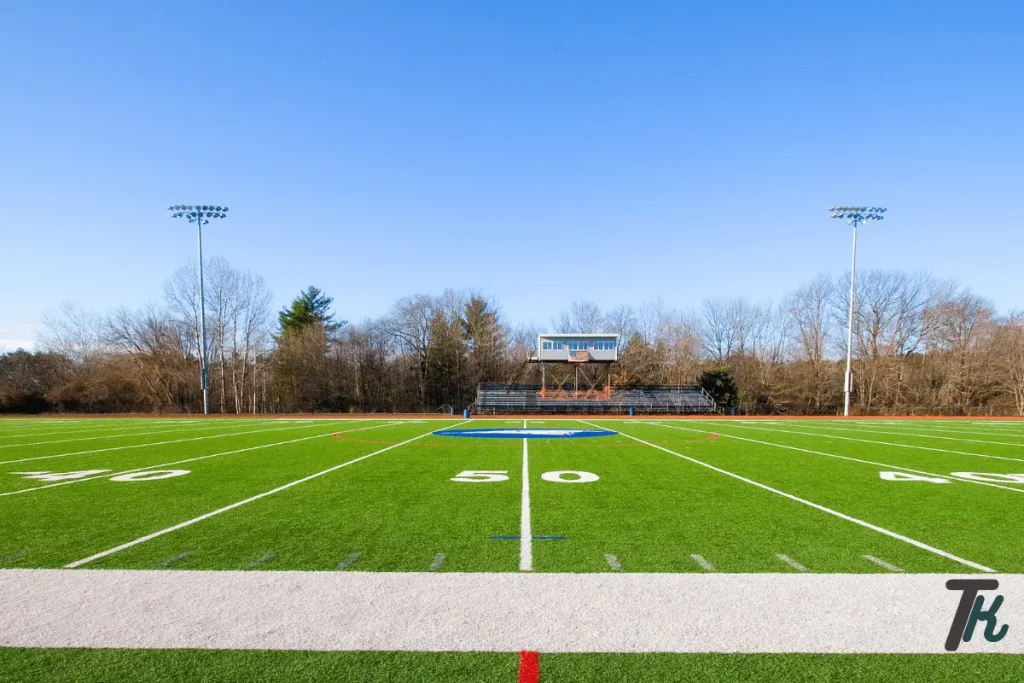As an Amazon Associate, I earn from qualifying purchases.
This article from the teamkathycarter website discusses Square Yards of a Football Field.
Understanding the dimensions of a football field is crucial for players, coaches, and fans alike. One key aspect of these dimensions is the concept of square yards, which plays a significant role in determining the size and layout of a football field. This article explores the importance of square yards in a football field, tracing the historical evolution of field dimensions, discussing standard measurements, calculating square yards, and highlighting the significance of square yardage in sports.
Historical Evolution of Football Field Dimensions
The dimensions of a football field have evolved significantly over time, reflecting changes in the game and advancements in sports infrastructure. Football fields have transformed remarkably from the rudimentary fields of the past to the standardized layouts we see today. Understanding this evolution provides valuable insights into how the game has developed and adapted to changing trends and technologies.
Key changes in field dimensions have profoundly impacted the game’s dynamics, influencing player strategies, team tactics, and overall gameplay. By examining the historical evolution of football field dimensions, we can appreciate the significance of these changes and their implications for the sport as a whole.
Standard Football Field Measurements
Official measurements for standard football fields vary depending on the football code being played. For example, soccer fields typically range from 100 to 130 yards in length and 50 to 100 yards in width, while American football fields are 120 yards long and 53.3 yards wide. Understanding these variations is essential for players, coaches, and officials to ensure fair play and compliance with regulations.
By highlighting the differences in dimensions for various football codes, we can deepen our understanding of each sport’s unique characteristics and appreciate the diversity of playing fields across different disciplines. This knowledge allows us to compare and contrast the nuances of each game, from soccer’s expansive pitches to American football’s compact grids.
Calculating Square Yards: The Basics
Square yards are a unit of measurement commonly used to quantify the area of a space, including football fields. Calculating the square yards of a football field involves multiplying the length and width of the field in yards. For example, a standard American football field measures 120 yards long and 53.3 yards wide, resulting in a total area of approximately 6,396 square yards.
Understanding the concept of square yards and how to calculate them is essential for groundskeepers, facility managers, and sports enthusiasts who are responsible for maintaining and organizing football fields. By mastering these basic calculations, we can ensure accurate measurements and optimal playing conditions for athletes and teams.
Importance of Square Yardage in Sports
Square yardage plays a crucial role in sports, influencing player strategies, game dynamics, and overall field aesthetics. The size and layout of a playing field can affect the speed of play, the positioning of players, and the tactical decisions made by coaches and teams. By analyzing the square yardage of a football field, we gain valuable insights into how space is utilized, how players interact with their environment, and how teams formulate their game plans. The dimensions of a football field not only impact the physical aspects of the game but also influence the mental and strategic aspects of competition.
The square yardage of a football field also contributes to the game’s overall aesthetics, shaping the sport’s visual appeal for fans and spectators. The size and shape of the field create a distinct atmosphere that enhances the viewing experience and adds to the excitement and drama of each match. By appreciating the importance of square yardage in sports, we can gain a deeper appreciation for the precision and craftsmanship behind the game.
Comparative Analysis with Other Sports Fields
To better understand the significance of square yardage in football fields, it is helpful to compare and contrast them with other popular sports fields, such as basketball courts and tennis courts. Each sport has its own unique dimensions and layout, tailored to the specific requirements and nuances of the game.
For example, a basketball court is typically smaller than a football field, measuring approximately 94 feet in length and 50 feet in width. In contrast, a tennis court is even smaller, measuring 78 feet long for singles matches and 36 feet wide for doubles matches. By exploring these variations, we can appreciate how different sports utilize space in distinct ways to accommodate their specific rules and gameplay styles.
Insights into how various sports fields are designed and configured offer valuable perspectives on the spatial dynamics of each game. By comparing the square yardage of different sports fields, we can identify similarities and differences in how space is managed, how boundaries are defined, and how players navigate their surroundings. This comparative analysis enhances our understanding of the strategic and tactical considerations that underpin each sport.
Challenges in Maintaining Football Field Dimensions
Ensuring precise football field measurements presents a significant challenge for groundskeepers, maintenance crews, and facility managers. Factors such as weather conditions, wear and tear from regular use, and technological constraints can all impact the accuracy and consistency of field dimensions.
To address these challenges, innovative solutions and practices have been developed to maintain football field dimensions with precision and reliability. Techniques such as laser measurement systems, GPS tracking, and computer-aided design (CAD) software have revolutionized field maintenance and enabled groundskeepers to uphold the integrity of playing surfaces.
By overcoming the challenges of maintaining football field dimensions, we can preserve the quality of the game, protect player safety, and uphold the standards of fairness and competition. Through continuous advancements in technology and best practices, we can ensure that football fields remain optimal for athletes and teams to perform at their best. By addressing the challenges of maintaining field dimensions, we demonstrate a commitment to excellence and professionalism in sports management, fostering a culture of respect for the game and the players participating in it.
Innovative approaches to field maintenance, such as specialized turf management techniques, regular inspections, and ongoing monitoring of field conditions, can help mitigate the impact of external factors on field dimensions. By taking a proactive stance on maintenance and investing in state-of-the-art technologies, sports organizations can ensure that football fields meet the highest standards of quality and consistency.
Solutions and innovations in maintaining football field dimensions benefit athletes and teams and enhance the overall fan experience. Well-maintained fields provide a visually appealing backdrop for matches, creating a sense of professionalism and prestige that reflects positively on the sport. By overcoming the challenges in maintaining field dimensions, we contribute to the sustainability and longevity of football as a beloved and respected sport worldwide.
Notable Football Field Anomalies
While most football fields adhere to standard dimensions and measurements, some notable anomalies and deviations have captured the attention of fans and enthusiasts. From unique field layouts to unconventional setups, these anomalies add an element of intrigue and fascination to the world of sports stadiums.
One famous example of a football field anomaly is the Azteca Stadium in Mexico City, which features a high-altitude location and a distinctive design that sets it apart from traditional stadiums. Another notable anomaly is the Arena da Baixada in Brazil, known for its innovative architecture and unconventional field orientation that challenges players and coaches alike.
We celebrate the diversity and creativity within sports architecture and design by showcasing these notable football field anomalies. These deviations from standard dimensions serve as testaments to the ingenuity and imagination of those pushing traditional stadium construction’s boundaries, creating memorable and iconic venues that inspire awe and admiration.
A final word about How Many Square Yards in a Football Field
Understanding the square yards in a football field offers valuable insights into sports field management’s dynamics, aesthetics, and challenges. By tracing the historical evolution of field dimensions, discussing standard measurements, calculating square yards, and exploring the importance of square yardage in sports, we gain a deeper appreciation for the precision and attention to detail that underpins the game of football.
Comparative analyses with other sports fields provide us with unique perspectives on how space is utilized and managed across different disciplines, enhancing our understanding of the strategic and tactical considerations that shape each sport. By addressing the challenges in maintaining football fields dimensions and showcasing notable anomalies in field design, we recognize the creativity and innovation that define the world of sports stadiums.
Ultimately, the square yards in a football field serve as more than just measurements—they represent a rich tapestry of history, strategy, and creativity that enriches the experience of players, fans, and enthusiasts alike. By delving into the intricacies of field dimensions, we deepen our understanding of the game of football and the meticulous planning that goes into creating and maintaining world-class sports facilities.
As we navigate the challenges of maintaining field dimensions, explore notable anomalies, and reflect on the historical evolution of football field sizes, we come to appreciate the artistry and engineering behind every aspect of the game. The precision and attention to detail required to ensure accurate measurements underscore the importance of field dimensions in shaping the very essence of football as a sport.
In conclusion,
the square yards in a football field are not merely numbers on a page—they reflect the passion, dedication, and craftsmanship that define the world of sports. By understanding and respecting the significance of square yardage in sports, we honor the legacy of football and the enduring spirit of competition that drives athletes and fans to new heights of excellence.
Through this exploration of square yards in a football fields, we invite you to step into the rich tapestry of sports history and indulge in the intricacies of field dimensions, calculations, challenges, and anomalies that make football such a captivating and dynamic sport. May this journey through the dimensions of the game inspire you to view football fields in a new light and kindle a deeper appreciation for the beauty and complexity of the sport we all love.
Thank you for joining us on this enlightening exploration of football fields’ square yards. May your passion for sports and outdoor activities continue to thrive as you embrace the precision and intricacies that define the world of football fields.
FAQ: Understanding Football Field Measurements and Acreage
Q1: How many square yards are in a football field?
A football field covers an area of approximately 57,600 square feet. Converting this area to square yards, we find 6,400 square yards in a standard American football field. This calculation is based on the field’s dimensions of 120 yards in length and 53.3 yards in width, yielding a total area of 6,400 square yards. Understanding this square yardage is crucial for various aspects of field management, maintenance, and game planning in football.
Q2: How many total yards are in a football field?
A football field typically measures 100 yards in length, consisting of two end zones, each 10 yards deep, and the main playing fields of 80 yards. When including the end zones, which are essential for scoring touchdowns, a football field totals 120 yards in length. This 120-yard span accommodates all the necessary components for gameplay, such as the field of play, goal lines, end zones, and sidelines, ensuring a standardized and regulated environment for football matches.
Q3: How many football fields are in an acre?
An acre of land, which measures 43,560 square feet or 4,840 square yards, could accommodate approximately 7.15 standard football fields. This estimation is based on the area of a single field being 6,400 square yards and taking into account the space needed to accommodate multiple fields while maintaining a safe distance between them. Understanding the number of football fields that can fit within an acre provides valuable insights for land use planning, sports facility design, and spatial management considerations.
Q4: How many yards long is 1 acre?
Acreage is typically represented in square units, not linear units like yards. However, when considering the square yardage of an acre (4,840 square yards), it is worth noting that a perfect square acre would be approximately 69.57 yards long on each side. This equates to a total perimeter length of roughly 278.28 yards around a one-acre area. While the notion of yards in relation to acreage might not directly align with area measurements, understanding the dimensions of an acre in linear terms provides a helpful perspective on the physical size and scale of land parcels.
As an Amazon Associate, I earn from qualifying purchases.




